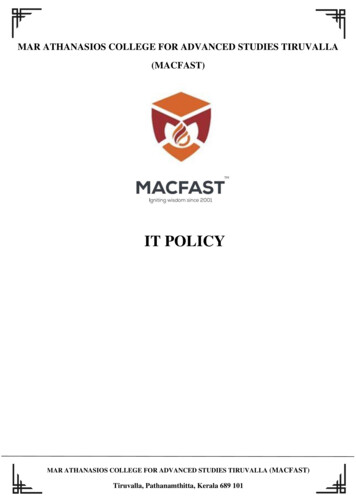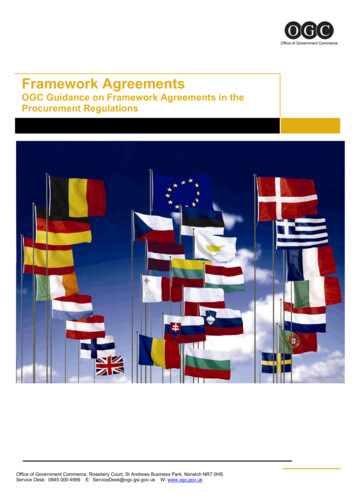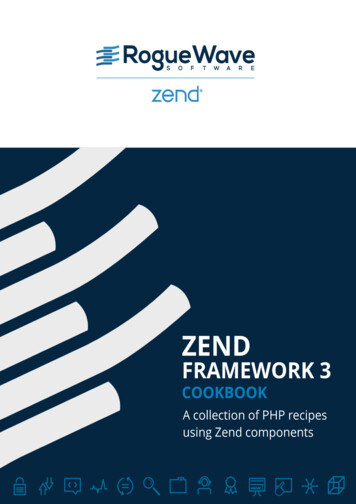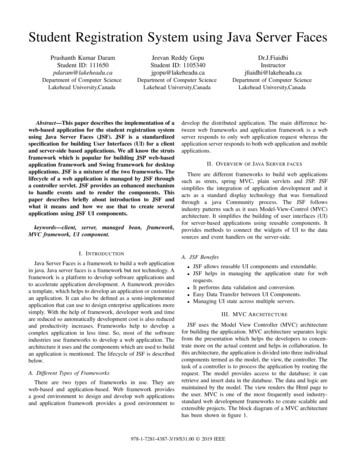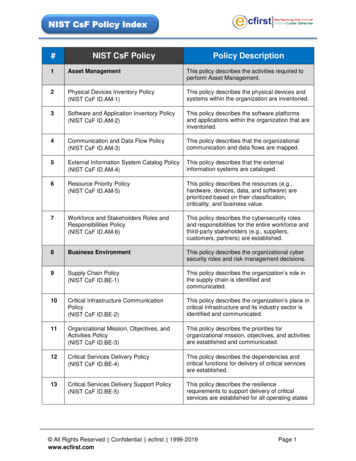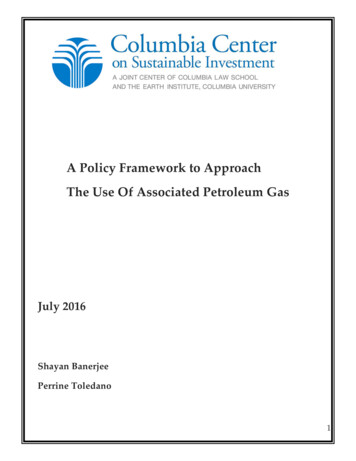
Transcription
A Policy Framework to ApproachThe Use Of Associated Petroleum GasJuly 2016Shayan BanerjeePerrine Toledano1
About the Columbia Center on Sustainable InvestmentThe Columbia Center on Sustainable Investment, formerly known as the Vale ColumbiaCenter on Sustainable International Investment, is a joint center of Columbia Law School and theEarth Institute at Columbia University and a leading applied research center and forum for thestudy, practice and discussion of sustainable international investment. Our mission is to developand disseminate practical approaches and solutions to maximize the impact of internationalinvestment for sustainable development. CCSI’s premise is that responsible investment leads tobenefits for both investors and the residents of host countries. Through research, advisoryprojects, multi-stakeholder dialogue and educational programs, CCSI focuses on constructingand implementing a holistic investment framework that promotes sustainable development andthe mutual trust needed for long-term investments that can be practically adopted bygovernments, companies and civil society.Acknowledgement:The authors are extremely grateful to Albert Bressand and Thomas Mitro, both senior fellowswith CCSI for their thorough reviews and inputs. The authors are also very grateful to the SabinCenter for Climate Change Law for conducting two case studies (Iraq and Russia).Suggested QuoteShay Banerjee, Perrine Toledano, “A Policy Framework to Approach the Use Of AssociatedPetroleum Gas,” Columbia Center on Sustainable Investment, Columbia University, (2016).2
Table of ContentsTABLE OF CONTENTS . 3I. OVERVIEW . 4A. DEFINITIONS . 5B. 3 OBJECTIVES IN MINIMIZING FLARING . 81. Eliminating Economic Waste . 82. Improving Environmental & Public Health . 83. Increasing Energy Access . 9C. NOTE ON THE METHODOLOGY . 9II. MODEL POLICY FRAMEWORK & RECOMMENDATIONS . 10A. RECOMMENDATION ONE . 10Key Takeaways from Recommendation One . 15B. RECOMMENDATION TWO . 15Key Takeaways from Recommendation Two . 18C. RECOMMENDATION THREE. 18Key Takeaway from Recommendation Three . 25D. RECOMMENDATION FOUR . 26Key Takeaways from Recommendation Four . 45CONCLUSION . 45III. ANNEXES . 46Annex 1: Using gas for on-site generation – Prevalent approaches . 46Annex 2: Representative molecule (MOL) compositions of various produced petroleum after separationat the surface . 473
I. OverviewCrude oil and natural gas consist of a combination of hydrocarbon molecules. Crude oil isa liquid both at normal surface and underground conditions while natural gas is a vapor atnormal surface conditions and underground, it can exist either as a “vapor or something like abottle of carbonated soda”.1 The lightest hydrocarbon is methane, with ethane, propane, butaneand “natural gasoline” being the increasingly heavier fractions. The larger the proportions ofheavier molecules in a hydrocarbon mixture, the more likely it is to exist as a liquid atatmospheric conditions.2,3Thus, historically, petroleum producers, only interested in the crude oil, disposed of lighterhydrocarbons by ‘venting’ them into the atmosphere, creating a byproduct known “AssociatedPetroleum Gas (APG).” Today, it is far more common for petroleum producers only seeking theliquid to instead flare the produced APG, a process that converts the lighter hydrocarbons intocarbon dioxide, water, and other chemical impurities. Both practices, with venting being worsethan flaring release highly detrimental greenhouse gases into the atmosphere.Since the hydrocarbons disposed as APG are potentially valuable and commercially viablesources of energy, venting and flaring activities are not only harmful to the environment andpublic health, but also waste a valuable non-renewable energy resource that could otherwisedrive positive economic outcomes. Efforts have been underway for decades to reduce flaring byextracting value from gases by selling them in markets for petrochemicals or power production(methane), decentralized heating and cooking (propane, butane), fuel for tractors (propane),among other uses. Strategic optimization of APG use would eliminate economic waste generatedby flaring, improve energy efficiency, expand energy access, contribute to climate changemitigation, and promote sustainable development.In 2015, the World Bank launched the “Zero Routine Flaring by 2030” initiative to callattention to the problem of routine flaring and encourage better utilization of APG on a globalscale.4 The initiative seeks to engage oil companies, governments, and development institutionsTraining modules of International Human Resources Development Corporation (IHRDC) available at:https://www.ihrdc.com/els/po-demo/module01/mod 001 02.htm2 “ In general, the deeper a rock formation is located in the Earth's crust, the higher its temperature will be. Thus, thetype of petroleum that formed through these processes depended largely on the depth of the source rocks. Inrelatively shallow source rocks, where temperatures ranged from about 60 to 80 C [140 -176 F], the organic matterwas converted into heavy oil. At lower depths and higher temperatures, from about 80 C to 175 C [176 F to 347 F],the heavier, long-chain organic molecules began to break up into shorter molecules and form medium and light oil.Where temperatures exceeded 175 C [347 F], the molecules became even shorter and lighter, with more and morematter transformed to rich gas until, by the time it had reached 600 F [315 C], all of it had been transformed to drygas (methane).” Source: IRDC, op. cit.3 See Annex or a composition of the different types of petroleum produced.4 The World Bank, “Zero Routine Flaring by 2030,” available at: laring-by-203014
in a unified effort to eliminate routine flaring at existing oil fields as soon as possible, and no laterthan 2030. Furthermore in December of that year, the 21st meeting of the Conference of theParties of the United Nations Framework Convention on Climate Change (COP 21) reached the“Paris Agreement5” that sets the goal of limiting global warming to “well below two degreesCelsius” above pre-industrial levels, and to strive to limit the increase to 1.5 degrees Celsius. “TheParis Agreement marks a historic milestone in curbing human-induced climate change, yet thereal challenge lies ahead, in implementation.”6To contribute to both the World Bank’s efforts and the implementation of the ParisAgreement, the Columbia Center for Sustainable Investment (“CCSI”) has reviewed case studiesfrom around the world and prepared the present policy paper to outline governmental andoperational strategies for successful broad-based deployment of APG use technology. As such,the paper should serve as guidance for regulators, policymakers, and industry leaders seeking todevelop practical approaches to unlock the economic value of APG.A. DefinitionsAPG is a broad term for gas associated with the oil in thereservoir, and therefore includes both gas dissolved in the oil(“solution gas”) and gas residing above oil in the reservoir(“gas cap gas”).7 Each of these APG types is described below. Solution Gas - Subsurface crude oil almost alwayscontains dissolved methane (CH4) and otherhydrocarbons including ethane (C2H6), propane(C3H8), butane (C4H10) and pentane (C5H12). Thosecomponents are released as APG when thereservoir pressure drops during the extractionprocess. Gas Cap Gas - A gas cap is present in a reservoir ifthe latent oil pressure is below bubble point8 at thetime of discovery (Figure 19). As oil is extracted, theFigure 1: Gas CapSource: AAPG WikiUNFCC’s Paris Agreement, available at: http://unfccc.int/paris agreement/items/9485.phpCCSI’s announcement its 11th Annual Columbia International Investment Conference, available sources-from-consensus-to-action/7 PFC Energy, “Using Russia’s Associated Gas: Prepared for the Global Gas Flaring Reduction Partnership & theWorld Bank,” (2007), available at: es/pfc energy report.pdf.8 In thermodynamics, a liquid’s bubble point at a given temperature is the pressure at which the first bubble of vaporforms.9 Retrieved from the open access resource for the petroleum geosciences community maintained by the AmericanAssociation of Petroleum Geologists (AAPG) at http://wiki.aapg.org/Drive mechanisms and recovery565
overlying gas cap expands downward and invades the producing oil zone. Over theproduction window, reservoir yield contains increasing amounts of APG andultimately only APG.The most abundant component of APG, and the one for which the largest market exists, ismethane. APG however always contains some fractions of the other “light” hydrocarbons, i.e.ethane, propane, normal butane, isobutene, pentanes and traces of heavier hydrocarbons usuallynoted as C5 (see Figures 7 and 8 in Recommendation 4). If these other gases are a very smallfraction (which practically means if the APG can be transported and sold like methane under thelocal market technical parameters applicable to “natural gas”), the gas is said to be “dry”. Bycontrast, APG will be called a “wet” gas if it contains a high concentration of the heavier gaseoushydrocarbons and cannot be transported and sold as “natural gas”. These other fractions, whichare referred to as Natural Gas Liquids (“NGLs”), must be separated from the methane10 at a GasProcessing Plant (“GPP”), which separates out dry methane from the other components.APG are also a significant component of reservoirs rich in condensates (the termcondensate, which does not have a precise definition, referring to a slightly broader spectrum ofhydrocarbons than NGLs). These reservoirs, which can also be referred to as light-oil reservoirs(as is the case for unconventional tight oil plays in the U.S.) consists mostly of light hydrocarbons.If, as is the case in the U.S., operators sell these condensates under the more favorable term of“light oil”, they will need to dispose of the lights fraction, namely methane with some residualNGLs. In such cases, the methane considered “associated” in relation to the production of thecondensates.Given rising energy demand globally, there is reason to believe that the revenue potential ofAPG utilization will grow over time. Technically, the “natural gas” component of APG can beused in a number of ways, including power generation in remote or regional markets, afterdistribution through high-pressure pipeline networks or under liquefied form, use for in-placeelectricity generation, and reinjection into the reservoir for enhanced oil recovery. After beingprocessed, NGLs are separated into their individual components that all have different marketoutlets and industries (see further details in Recommendation 4). The industry usage aredetermined by practical considerations (e.g. the fact that that the heavier gases can become liquidat the pressure and temperature of pipeline transportation or other critical operations) and bycommercial considerations, most notably the thermal content accepted for the sale of “naturalgas” to industrial and retail users (“natural gas” being mostly methane with some acceptablesmall fraction of ethane and traces of other gases).If a company seeks to produce oil but has not deployed a comprehensive strategy for APGutilization, however, the company must dispose of accumulated APG to avoid the risk of fire andexplosion within production facilities. The most conventional disposal instrument involves thecontrolled burning of the APG. This method, called “flaring,” disposes of the gas by releasing it10N. Hyne, Dictionary of Petroleum Exploration, op. cit, pp. 204.6
into the air. Chemically, flaring works by stimulating combustion reactions between the gaseoushydrocarbons and atmospheric oxygen in the air.11 A properly designed flare system operates at98% combustion efficiency or higher, so the main outputs are water vapor (H2O) and carbondioxide (CO2).12 The 1-2% of incomplete combustion produces carbon monoxide (CO), blackcarbon, total hydrocarbons, particulate matter, and volatile organic compounds.13“Venting” is another disposal mechanism that is rather rare today and that was vastly used afew decades ago in oil fields. Now however it is remains an issue with the gas fields where somegas can be vented in case of gas well testing, planned and unplanned non-routine depressuring ofprocessing equipment and gas pipelines. It involves the direct release of the APG into theatmosphere.14 If the APG is released at a high enough pressure, the hydrocarbons mix with the airwithout the need for combustion. In comparison to flaring, venting releases larger quantities ofmethane and volatile organic compounds into the atmosphere.Often, flaring that is considered “routine” occur due to the normal operations of the facility,with individual event durations ranging from 1-hour to 1-year.15 In contrast, safety flares may benecessary in emergency situations when equipment pressure poses an explosion or injury threat.Additional flaring over and above a normal or zero flare situation can also often take place over afew days, weeks or months whenever certain normal events take place, such as completion andhook-up or repairs and maintenance of a gas pipeline.Apart from the abnormal situations of flaring mentioned above, there is another technicalreason why eliminating flaring completely is not achievable. Natural depletion and pressuredeclines often means that the APG being produced is higher at the beginning of a project andlower at the end. In contrast, a GPP will possess a maximum processing capacity that does notfluctuate and is invariably lower than the maximum production capacity of the field. This isdone so as not to overbuild capacity and add unduly to the capital and operating costs. Thus,particularly in the early years, the APG produced is greater than APG processed, creating a needto flare the surplus APG. This flaring can be somewhat controlled by timing of when individualwells come on to production or by choking back production, but the alignment between the gasfield production and the gas processing plant will never be perfect.J. Kearns et. al., “Flaring & Venting in the Oil & Gas Exploration & Production Industry,” OGP EnvironmentalQuality Committee (Jan. 2000), available at: http://www.ogp.org.uk/pubs/288.pdf.12 “Processing Natural Gas,” NaturalGas.org, op. cit.13 Caliber Flaring,“What is Flaring” (2016), available nt faq§ion flaring14 “Processing Natural Gas,” NaturalGas.org, op. cit.15 Non-Routine Flaring Management: Modeling Guidance, Alberta Environment & Sustainable ResourceDevelopment, pp. 3, available at: 117
B. 3 objectives in minimizing FlaringCCSI considers each of the following objectives to be relevant to the broader goal ofsustainable development in the field of APG utilization.1. Eliminating Economic WasteFlaring wastes a valuable resource that could be used to advance the development ofproducing countries. For example, if all APG currently subject to flaring were used for powergeneration, the world would enjoy an additional 750 billion kWh of electricity – more than theentire African continent’s current electricity consumption.16 Alternatively, and as previouslystated, APG could be utilized in a number of productive ways unrelated to power generation.Since APG is non-renewable, this shortfall in economic value can never be gotten back.A central objective of government APG regulation should be to optimize the economic valuefrom APG utilization now and in the future. Policies must foster incentives to encourageconsideration of the economic benefits of APG utilization at the planning stage.2. Improving Environmental & Public HealthAs previously discussed at length, flaring causes considerable damage to theenvironment and to human health. From the perspective of mitigating climate change, accordingto the World Bank’s Global Gas Flaring Reduction Partnership, flaring produces a substantialgreenhouse gas footprint, resulting in approximately 300 million tons of global emissions eachyear.17 Here, it should be noted again that while flaring releases mainly carbon dioxide emissions,venting releases mainly methane emissions. Since the global warming impact of methane is 21times higher than that of carbon dioxide,18 flaring is preferable to venting for sustainabilitypurposes, though both are harmful to the environment. For this reason, venting is often fullyprohibited while flaring can be allowed under exceptional circumstances. Minimizing flaringwould reduce carbon emissions as much as removing 77 million cars from the road19 and wouldgo along way towards the implementation of the Paris Agreement.Air pollution associated with flaring and venting can result in chronic health problems,including bronchial, chest, rheumatic, and eye illnesses.20 Flaring also negatively impactslivelihood, causing acid rain that damages local crops, building structures, and surroundingecosystems. An optimal APG utilization strategy should seek to minimize greenhouse gasemissions and damage to surrounding communities.The World Bank, “Zero Routine Flaring by 2030,” op. cit.The World Bank, “Zero Routine Flaring by 2030,” op. cit.18 Living Earth, “What are the impacts of flaring and venting?”, available at: g-and-venting/19 The World Bank, “Countries and Oil Companies Agree to End Routine Gas Flaring,” Press Release (April 17, 2015),available at: utine-gas-flaring20 The World Bank, “Zero Routine Flaring by 2030,” op. cit.16178
3. Increasing Energy AccessSeveral oil-producing countriesFigure 2 Electricity Access Rates in APG Producinghave not developed a ation with access to modernenergy sources. For example, Angolahas achieved an electricity access rateof only 37%.21 (See Figure 2). In suchcountries, there is significant potentialin the use APG to meet the energyneeds of citizens. Furthermore, for oilfields that exist far from aninterconnected grid, APG solutionssuch as their use in local powerSource: World Bank, 2012generation may represent an attractiveway to reduce costs associated withexpensive purchased diesel or heavy fuel. Since energy consumption is a key driver of economicgrowth, an important function of APG utilization strategy is to reduce the overall cost of energyfor as many individuals as possible.C. Note on the methodologyWhile entering the technical intricacies, market constraints and institutional challenges ofAPG use, this paper proposes a model policy framework for policy makers structured aroundfour recommendations. These recommendations are informed by an extensive literature review,interviews with experts and a set a case of studies that CCSI conducted in detail: Angola, Canada,Equatorial Guinea, Ghana, Indonesia, Iraq22, Kazakhstan, Mexico, Nigeria, NorthDakota, Norway, Republic of the Congo, Russia23 and Texas. As shown in Figure 3, some of thesecountries are among the top twenty gas flaring countries, while others are among the bestperformers. The analysis and policy recommendations in this paper involved the conclusionsdrawn from all of these studies.World Bank Table on Access to Electricity by Country, 2012.Iraq’s case study was carried out by the Sabin Center for Climate Change Law at Columbia University and CCSI.23 Russia’s case study was carried out by the Sabin Center for Climate Change Law at Columbia University and CCSI.21229
Figure 3: Top 20 gas flaring countriesSource: NOAA Satellite Estimates, 2012 24II. Model Policy Framework & RecommendationsA. Recommendation OneDelegate regulatory oversight of flaring abatement policy to a single independent agency or corporationwith credible powers to enforce said policy. Where use of an independent regulator is not possible, takeadequate steps to create a credible and transparent enabling environment for investors.Any fiscal, monetary, or reporting framework aimed at converting flaring operations to APGutilization operations must be based on robust regulatory fundamentals. In particular, thepresence of a strong, independent regulatory body to measure and report requirements, monitorflare and vent volumes, enforce regulations, and compel the payment of penalties, is generallypreferred, particularly when there is some state interest in petroleum development projects.Indeed, the centrality of an independent regulator to a successful flaring abatement regime isdiscussed widely and at length in the literature,25 and our case studies have confirmed that thisfactor is quite significant to the success of utilization regimes.According to the World Bank, “NOAA is currently processing 2013 data and working to calibrate the data toderive estimates of flare volumes. However, a number of circumstances, including the use of new VIIRS infraredtechnology for more accuracy, have delayed the process. The World Bank-led Global Gas Flaring ReductionPartnership and NOAA are working to make 2013 gas flare volume estimates available as soon as possible.” 25 Global Gas Flaring Reduction Partnership, “Guidance on Upstream Flaring & Venting,” Policy Regulation (2009),available at: es/fr policy regulations guidance.pdf.2410
The Texas case study is instructive in that matter (See Box 1).Box 1: Texas – The state of the art of an independent regulatorThere, flaring is regulated by the Texas Railroad Commission (“RRC”) and the TexasCommission on Environmental Quality (“TCEQ”) , each of which approaches flaring regulationfrom a different slant. The RRC in particular is mostly concerned with preserving nonrenewableenergy resources. Thus, the RRC regulations, which have been operative since 1947, strive toprohibit the wasteful flaring of APG.26 The RRC, which under state law exerts primary regulatoryjurisdiction over the oil industry, issues flaring permits to well operators under its Statewide Rule32, a power that the Texas Supreme Court has upheld on three separate occasions.27 Over the lastseveral decades, the RRC has used this power to issue fines, warning notices, and bring suitsagainst companies across the state that violate flaring regulations. Some argue that the RRC couldstand to use its powers more extensively than it has, 28 but there is little debate that the agencyserves as a credible counterbalance to oil and gas interests when it comes to effective utilizationof APG.In addition, operators in Texas seeking to commit to flaring must apply for standard airpermits through a process administered by the TCEQ. Unlike the RRC, the TCEQ is primarilyconcerned with addressing air pollution that arises out of flaring. Pursuant to Title V of the CleanAir Act, the TCEQ, as a state agency, is charged with reviewing and approving air pollutionpermits for industrial and commercial sources. Although the TCEQ, as the state agency, is giventhis authority under the statute, the federal EPA may take control if it determines that monitoringof air pollution is inadequate – adding an additional layer of accountability to regulatoryapparatus. Recently, the TCEQ has used its authority under the Clean Air Act to regulate flaringactivities with the goal of limiting air pollution. During this process, the TCEQ may attachconditions that it sees fit based on the facility's location and individual characteristics. The permititself also enters the public domain and becomes available for comments from the public duringthe TCEQ's evaluation. This serves as an opportunity for community groups and other localgoverning bodies to raise concerns about the impact of the flaring activities at issue.29 Citizens arealso able to issue complaints to the TCEQ about air pollution resulting from flaring. The TCEQtypically responds to such complaints within twenty-four hours and subsequently conducts anon-site investigation to ensure compliance with environmental regulations. If a violation of airquality standards is found, the TCEQ takes “appropriate enforcement action” to ensure that theTex. Admin. Code §3.32.For instance in 1947, RRC issued an order shutting in all 615 oil wells in Seeligson Field in South Texas until flaringof APG was eliminated and measures were taken to utilize the gas. Operator filed suits challenging the orders. TheTexas Supreme Court upheld the RRC orders (source: D, Otiotio, "Gas flaring regulation in the oil and gas industry:A comparative analysis of Nigeria and Texas regulations," Academia.edu (May 2013).)28 J. Tedesco and J. Hiller, “Top Flaring Sites Lacked State Oversight,” San Antonio Express News (2015), available 32626.php29 NSR Guidance for Flares & Vapor Combusters, TCEQ, available ance/newsourcereview/flares/nsr fac flares.html262711
violation is corrected and notifies the submitter of the complaint in writing about the results ofsuch actions. After the notification is issued, the submitter is given the opportunity to publiclycomment on the resolution. The entire process, from submission to resolution and comment canbe tracked online. During 2015, over 7,500 air pollution complaints were resolved under thissystem.30 In this way, the TCEQ leverages transparency and direct public engagement to maintainits credibility and pursue enforcement as an independent regulator.While not all countries possess the financial and human resources to replicate the regulatoryapparatus described above, the Texas example demonstrates how delegating regulatory authorityto an agency that maintains a certain degree of independence can aid in flaring abatement efforts.For the reasons discussed below, failure to provide jurisdiction over flaring activities to anindependent regulator can become a roadblock to effective APG utilization.As discussed in greater detail in Recommendation Two, there will be many instances in whichthe interests of the operator conflict with the pursuit of otherwise socially optimal flaringabatement. In such cases, a system regulator whose interests are insufficiently severed from theproduction and marketing interests of oil companies is unlikely to hold operators fullyaccountable for flaring activities. The case study in Nigeria is illustrative (See Box 2).Box 2: Nigeria - Regulation and conflict of interestIn Nigeria, oversight of flaring regulations – along with all oil and gas
Thus, historically, petroleum producers, only interested in the crude oil, disposed of lighter hydrocarbons by 'venting' them into the atmosphere, creating a byproduct known "Associated Petroleum Gas (APG)." Today, it is far more common for petroleum producers only seeking the


